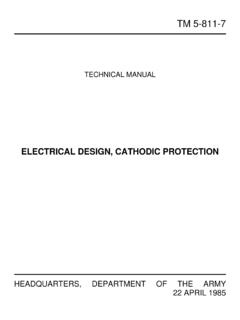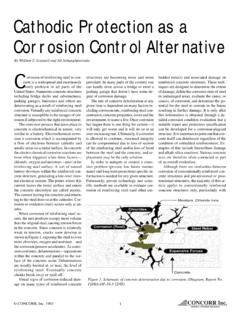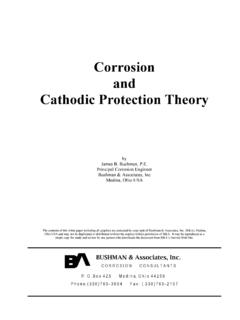Transcription of The importance of cathodic protection for the corrosion ...
1 5/22/2017 The importance of cathodic protection for the corrosion prevention of metallic underwater structures BATSOULI DESPOINA KARAKIZIS PANAGIOTIS 1 | P a g e 1. cathodic protection cathodic protection is the most important corrosion control method. For instance, via an external electrical current source corrosion can be limited and thus the metallic surface not be affected by the corrosive environment. cathodic protection can be utilized in order to protect several metals such as steel, copper, lead and bronze in every soil type and in the majority of the aqueous media. Via cathodic protection pitting corrosion can be avoided in metals that can be passivated such as stainless steel or aluminum.
2 It can also be used in order to limit stress corrosion cracking as well as fatigue and intergranular corrosion but not hydrogen embrittlement. This method is most commonly used in order to protect metallic underwater structures such as oil platforms, pipeline networks and even the hull of ships. The basic principal of the method is the connection of an external anode to the metal that is going to be protected with the subsequent direct electric current flow in order all the areas of the metallic surface to be cathodic and thus not get corroded. More specifically cathodic protection prevents corrosion by converting all of the anodic (active) sites on the metal surface to cathodic (passive) sites by supplying electrical current (or free electrons) from an alternate source.
3 Usually this takes the form of galvanic anodes, which are more active than steel. There are two types of cathodic protection : a) cathodic protection via sacrificial (galvanic) anodes (metals) b) Impressed current cathodic protection (via an external electric source) 2. cathodic protection via sacrificial anodes In the sacrificial anodes method a more anodic metal than the protected metallic surface gets connected to it. This dissimilar metal connection in the same environment results in the formation of a galvanic cell, where the more anodic metal gets corroded faster providing the current for the protection of the less anodic one (see Figure 1). 2 | P a g e Figure 1. The chemical reactions that take place during the cathodic protection via sacrificial anodes.
4 Metals such as zinc, aluminum and magnesium can be used as anodes for the protection of a steel metal structure. In Figure 2 two different anode types are presented, the conventional one (Figure 2a) and the U channel type (Figure 2b). Figure 2. (a) A conventional anode and (b) a U-channel anode. Nevertheless, for the protection of a large metallic structure like an oil rig the size and the number of the sacrificial anodes as well as the rate of consumption should be taken into consideration in order to know the replacement time. In Figure 3 some more complicated custom anodes are presented. In this case small metal plates are welded on the structure and the anodes are bolted on these plates in order to be easier to replace the anodes when the time comes.
5 An additional copper wire is used in order to assure the electrical conductivity between the anode and the plates. 3 | P a g e Figure 3. (a) The anodes and the metal plates, (b) the copper wire, and (c) as welded underwater. Last but not least, because this method is based on the creation of a proper galvanic cell, the anodes should have a decent electric contact with the protected surface. As a result direct welding of the anodes to the protected surface is mandatory. At this point it should be mentioned that this type of welding is known as Coded Wet Hyperbaric Welding and is regulated by the AWS : 2010 as well as the EN ISO 15618-1: 2002 international standards (American and European respectively) and only Coded Wet Welders should apply it.
6 In Figure 4 a coded wet weld from the company MAREX SUBSEA WELDS is presented on the job. Figure 4. A coded wet welder on the job. 4 | P a g e 3. Impressed current cathodic protection In the method of impressed current cathodic protection electrical current is supplied to the protected metal at an equal or higher rate than the equivalent that the current exits the metal during corrosion (see Figure 5). Figure 5. Simple impressed current cathodic protection system. A source of DC electric current is used to help drive the protective electrochemical reaction. The impressed current cathodic protection (ICCP) systems usually consist of anodes connected to a DC power source, often a transformer-rectifier connected to AC power.
7 cathodic protection transformer-rectifier units are often custom manufactured and equipped with a variety of features, including remote monitoring and control, integral current interrupters and various types of electrical enclosures. The output DC negative terminal is connected to the structure to be protected by the cathodic protection system. The rectifier output DC positive cable is connected to the anodes which are available in a variety of shapes and sizes. Common anodes are tubular and solid rod shapes or continuous ribbons of various materials including high silicon cast iron, graphite, mixed metal oxide, platinum and niobium coated wire and other materials. 4. Pros and cons of the methods - conclusion The ICCP technique has been used since the 1950s for the protection of ship hulls.
8 It should be mentioned that this technique should always be used in combination with protective coatings. These coatings are the primary method of protection whereas the ICCP protects the areas where the coatings present defects or fails altogether. During the ships lifespan these coatings deteriorate and consequently the ICCP requirements are increasing continuously and may eventually exceed the system s capabilities. These high currents may also further destroy the protective coatings in areas where the hydroxyl ions concentration is high. Additionally these high anodic local currents may reduce the protection provided to the rest of the structure. This high degree of uncertainty in combination with the difficulty of compensation for the large fluctuations in the corrosion potential (originating from the variations of the properties of the 5 | P a g e corrosive environment) and the risk to accelerate the corrosion rate if the external voltage is greater than needed results in the limited application of this method in large structures such as rigs and platforms.
9 Some of the complicated components of the system along with the anodes can be swept away by the waves and it is considered that the sacrificial anodes application provides greater reliability for the lifespan of the construction which amounts to 25 years. It should be mentioned though that although the sacrificial anodes method can be used in any structure, it is preferred for cases of small current requirements specific electrolyte resistance lower than 10,000 ohm*cm. Additionally, although the sacrificial anodes should be replaced relatively frequently, it can be a cheaper solution compared to the ICCP method due to the lack of special equipment. The sacrificial anodes system has a breakeven point of around 10 years compared to the installation and ongoing costs of an ICCP system, due to the ICCP maintenance need.
10 Nevertheless it should be pointed out that the application of the welds should be always done by experienced coded wet welders in order for the welding to be sound and thus the electrical conductivity between the anode and the metal structure assured. In Figure 6 several sound welds made by welders from the MAREX SUBSEA WELDS company are presented. Figure 6. Underwater welding of the anodes to the steel structure. Note the defect free welds which contribute to the creation of the galvanic cell. 6 | P a g e 5. An example of cathodic protection on submerged platforms The requirements of a submerged platform with regard to the corrosion protection are determined to a big extent by the exposure conditions.








![Corrosion Protection.ppt [Read-Only] - University of Iowa](/cache/preview/1/c/f/9/2/e/d/5/thumb-1cf92ed5cf903dbf2b6cd3a840081a01.jpg)
